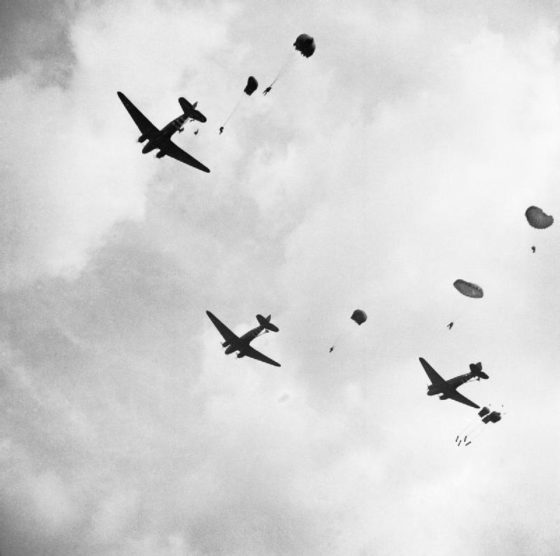
“Under ideal conditions, Panzerschrecks were enormously effective.
A single shot could usually knock out an enemy tank.”
THE PANZERSCHRECK OR “tank fright” was a German-built hand-held anti-tank weapon that made life uncomfortable for Allied tank crew, especially in urban areas. Here are five things you ought to know about this fearsome Axis weapon.

The Weapon Was Based on the American Bazooka
In 1943, German forces in Tunisia captured a quantity of U.S. 2.36-inch anti-tank weapons. The weapon, which was known informally as the Bazooka, was of immediate interest to the Axis, who commissioned the development of a Wehrmacht equivalent. The result was the Raketenpanzerbüsche 43 (RPzB 43). The design was clearly indebted to the U.S. weapon, but with some key improvements. Among these was the RPzB 43’s 88mm shaped-charge warhead – it provided better penetrative capability than the 60mm U.S. version. Rounds were fired electrically via an impulse magneto, something that the U.S. Army adopted for later Bazooka models like the M9/M9A1 — earlier variants used a battery ignition system.
Panzerschrecks Were Cheap and Easy to Manufacture
Panzerschrecks were produced in huge numbers from facilities like the HASAG works in Meuselwitz. In total, some 290,000 launchers of all variants were manufactured, along with over two million rockets.

Panzerschreck Crews Were Marked Men
The Panzerschreck was nicknamed the Ofenrohr (stovepipe) by German troops because of the large amount of smoke and dust it generated during firing. These clouds often gave away the position of Panzerschreck teams to enemy infantry and tanks. As a result, rocket crews would have to move fast after a launch or risk being killed by enemy small-arms fire, all of which could outdistance the relatively short 180-metre effective range of the Panzerschreck.

The Panzerschreck Often Injured Its Users
During firing, the RPzB 43 missile left the tube in full burn, something that made life unpleasant for the user. Gas masks and fire-retardant clothing were often essential when shooting a Panzerschreck. Later models, like the RPzB 54 (built from mid-1944 onwards), provided a shield on the launcher to reduce this problem, although this increased the weight of the weapon to 11kg (24.2lb) from 9.5kg (20.9lb). Variants like the the RPzB 54/1 had a slightly shorter tube, but improved RPzBGr 4992 rockets provided an increased range but offered a reduced blast issue since most of the propellant was consumed in the tube. Even with these refinements, anyone standing up to 10m (32 feet) behind the weapon risked serious injuries from the weapon’s back-blast.

The Panzerschreck Was Deadly in Close Combat
As with other shoulder-launched rocket weapons such as the Panzerfaust, users had get dangerously close to an enemy tank in order to destroy it. In battle zones such as Normandy, this often involved setting up roadblock ambushes along wooded trails and then attacking enemy tanks as they came to a halt. Alternatively, Panzerschreck teams operating in open country would often lie unseen when tanks approached making use of any available obstacle or shell hole for cover. Once the weapon was fired, Panzerschreck crews were exposed and could expect to face a torrent of fire. Not surprisingly, the weapons were most effective in urban areas where combat took place at much closer ranges. The ample cover also gave crews virtually limitless firing positions and just as many escape routes.

Under ideal conditions, Panzerschrecks were enormously effective. A single shot could usually knock out an enemy tank — it wasn’t called “tank terror” for nothing. Because of the devastating effect of the weapon, Allied armoured units often covered their vehicles with sandbags, track links or other similarly improvised protection. This created a stand-off distance that reduced the penetrative effect of the shaped charge on a tank’s main armour. Sometimes even that wasn’t enough. One eyewitness with the Canadian 5th Canadian Armoured Division recalled seeing comrades from the British Columbia Dragoons tangle with enemy Panzerschrecks.

“The BCDs ran into a hornet’s nest… Paratroopers fired on the lead tanks with their extremely effective Panzerfausts and Panzerschrecks, both much feared by our tank crews,” said Stanley Scislowski, Perth Regiment, 11th Infantry Brigade, 5th Armoured. “Later… we passed two Shermans jammed up together. The front tank’s turret was blown off and lying several yards off to the side, giving a good indication of the destructive power of the shaped-charge anti-tank bombs.”
 You can find out more about the Panzerschreck’s role in German anti-tank tactics in Normandy in a “Rapid Read” eBook The Defence of St Lô ’44, available for £1.99 (or dollar equivalent) on Amazon and also on the German War Machine website www.germanwarmachine.com.
You can find out more about the Panzerschreck’s role in German anti-tank tactics in Normandy in a “Rapid Read” eBook The Defence of St Lô ’44, available for £1.99 (or dollar equivalent) on Amazon and also on the German War Machine website www.germanwarmachine.com.










2 thoughts on “Panzerschreck — Five Amazing Facts About the German Bazooka ”